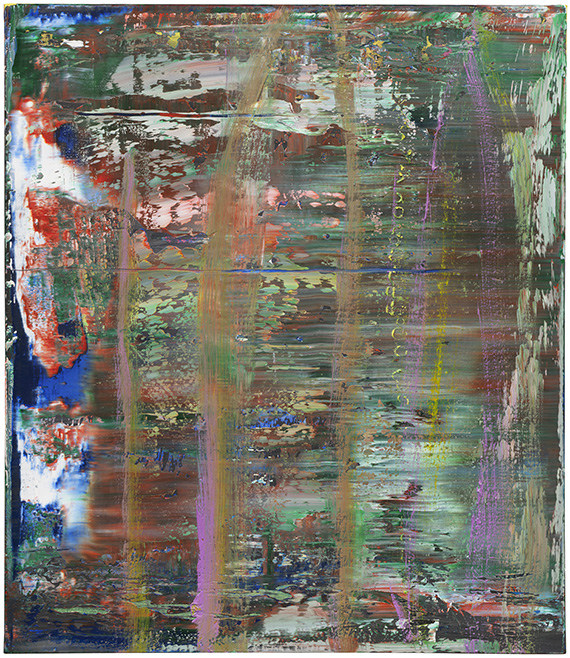12
Gerhard Richter
Abstraktes Bild, 1989.
Oil on canvas
Estimation:
€ 1,500,000 / $ 1,740,000 Résultat:
€ 1,802,500 / $ 2,090,899 ( frais d'adjudication compris)
Abstraktes Bild. 1989.
Oil on canvas.
Signed, dated and inscribed with the work number "704-3" on the reverse. 72 x 62 cm (28.3 x 24.4 in). [JS].
• From Richter's most sought-after creative period (1986–1990), when the use of the squeegee dominated his painting for the first time.
• Outstanding quality and depth: Gerhard Richter describes this phase of his work as the mature period of his “Abstract Paintings.”
• Following the iconic RAF cycle (1988, Museum of Modern Art, New York), Richter revisited a spring-like, bright color palette in the present work.
• A tense symbiosis of squeegee and brush, calculation and chance, depth and lightness.
• Paintings from this creative phase are in the most important collections worldwide, including the Museum of Modern Art, New York, the San Francisco Museum of Modern Art, the Tate Modern, London, and the National Museum of Art, Osaka.
PROVENANCE: Galerie Fred Jahn, Munich.
Private collection South Germany (acquired from the above in 1991).
Private collection Hesse (gifted from the above in 2014).
EXHIBITION: Gerhard Richter. Fotoeditionen, Aquarelle und Bilder, Galerie Jahn und Fusban, Munich 1991.
LITERATURE: Dietmar Elger, Gerhard Richter. Catalogue raisonné, vol. 4: 1988-1994, Ostfidlern 2015, no. 704-3 (illustrated in color on p. 259).
- -
Gerhard Richter. Werkübersicht / Catalogue raisonné 1962-1993, Kunst- und Ausstellungshalle der Bundesrepublik Deutschland, Bonn 1993, vol. III, cat. no. 704-3 (illustrated).
“In the 2011 documentary Gerhard Richter, Painting, [Ulrich] Wilmes characterizes these paintings as 'mature'. Richter distinguished this creative phase [.] from his earlier abstract paintings as the 'more grown-up' one."
Dietmar Elger, quoted from: Gerhard Richter. Catalogue raisonné, vol. 4: 1988-1994, Ostfidlern 2015, p. 35.
"The pictures thrive on the viewer's desire to find meaning in them. At every point, they reveal similarities to real phenomena, though these cannot be properly explained. It's like in music, which evokes moods because it resembles real sounds. [..] They remind us of something, otherwise they wouldn't be picturres at all. "
Gerhard Richter, 1999, quoted from: Gerard Richter, Text 1961 bis 2007, Cologne 2008, pp. 360ff.
Oil on canvas.
Signed, dated and inscribed with the work number "704-3" on the reverse. 72 x 62 cm (28.3 x 24.4 in). [JS].
• From Richter's most sought-after creative period (1986–1990), when the use of the squeegee dominated his painting for the first time.
• Outstanding quality and depth: Gerhard Richter describes this phase of his work as the mature period of his “Abstract Paintings.”
• Following the iconic RAF cycle (1988, Museum of Modern Art, New York), Richter revisited a spring-like, bright color palette in the present work.
• A tense symbiosis of squeegee and brush, calculation and chance, depth and lightness.
• Paintings from this creative phase are in the most important collections worldwide, including the Museum of Modern Art, New York, the San Francisco Museum of Modern Art, the Tate Modern, London, and the National Museum of Art, Osaka.
PROVENANCE: Galerie Fred Jahn, Munich.
Private collection South Germany (acquired from the above in 1991).
Private collection Hesse (gifted from the above in 2014).
EXHIBITION: Gerhard Richter. Fotoeditionen, Aquarelle und Bilder, Galerie Jahn und Fusban, Munich 1991.
LITERATURE: Dietmar Elger, Gerhard Richter. Catalogue raisonné, vol. 4: 1988-1994, Ostfidlern 2015, no. 704-3 (illustrated in color on p. 259).
- -
Gerhard Richter. Werkübersicht / Catalogue raisonné 1962-1993, Kunst- und Ausstellungshalle der Bundesrepublik Deutschland, Bonn 1993, vol. III, cat. no. 704-3 (illustrated).
“In the 2011 documentary Gerhard Richter, Painting, [Ulrich] Wilmes characterizes these paintings as 'mature'. Richter distinguished this creative phase [.] from his earlier abstract paintings as the 'more grown-up' one."
Dietmar Elger, quoted from: Gerhard Richter. Catalogue raisonné, vol. 4: 1988-1994, Ostfidlern 2015, p. 35.
"The pictures thrive on the viewer's desire to find meaning in them. At every point, they reveal similarities to real phenomena, though these cannot be properly explained. It's like in music, which evokes moods because it resembles real sounds. [..] They remind us of something, otherwise they wouldn't be picturres at all. "
Gerhard Richter, 1999, quoted from: Gerard Richter, Text 1961 bis 2007, Cologne 2008, pp. 360ff.
Richter's “Abstrakte Bilder” (Abstract Paintings) – The painterly completion of a lifetime's achievement
'There comes a point when it is just over,' was Richter's straightforward announcement of the end of his artistic career in 2020. Richter decided that the time had come to officially draw a line under an oeuvre characterized by an almost religious devotion to the squeegee. 'It is not so bad. Moreover, I am old enough now.” (Quoted from: Zeit Online, Sept. 22, 2020) Now that painting with the squeegee, the large spatula-like paint scraper, had become too strenuous, Richter decided to limit himself to small-format works on paper. Anyone who has watched “Gerhard Richter Painting,” the 2011 documentary film by Corinna Belz about the undisputed superstar of the international art scene, will not forget the scenes shot in his studio: They reveal an artist in the throes of creative activity, a process almost silent in its choreography, seemingly following an unpredictable script in the artist's mind. Every step is meticulously planned, and while the result of ever-new and unique color gradients created by the squeegee is mainly unpredictable, it is, in fact, the product of calculated chance.
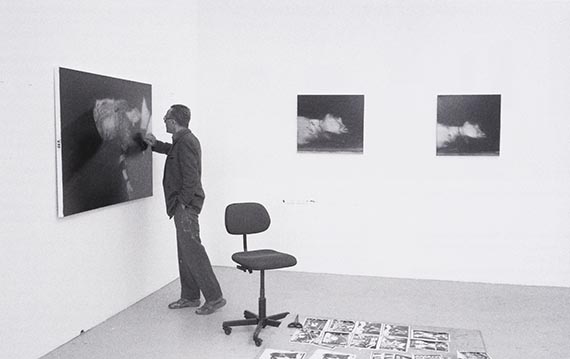
In his legendary “Abstract Paintings” series, Richter struck a perfect and fascinating balance between artistic method and chance, ultimately developing his inimitable signature style. What is also intriguing about these works is the perpetual interplay between construction and deconstruction: to create a new aesthetic impression, the existing application of paint must be “destroyed” over and over again. Richter is a rigorous perfectionist: nothing escapes his trained eye, and even the slightest imbalance in the composition or a minor dissonance in the color gradient is either corrected with utmost precision or discarded. The internationally celebrated result of this fascinating working process is a highly diverse and consistently high-caliber painterly oeuvre that, starting with catalogue raisonné number 1, “Tisch” (1962), Richter's first black-and-white photo painting, spans more than half a century and, in terms of its diversity, artistic quality and art-historical appreciation, is comparable only to the oeuvre of Pablo Picasso.

Richter's apogee – the iconic "October cycle" (1988) and the mature “Abstract Paintings”
The cycle of paintings entitled October 18, 1977 (also known as the RAF or October Cycle), was created in 1988 and purchased for the collection of the Museum of Modern Art, New York, is today it is considered an iconic work that represents a decisive turning point in Richter's practice. The then 56-year-old artist realized that after completing these fifteen black-and-white photo paintings based on press photos showing veiled fragments of the life and death of the terrorists of the Baader-Meinhoff group who were found dead in their prison cells, it would be more than challenging to return to the “Abstract Pictures” that he had started previously. “I also notice that these pictures set a new standard, pose challenges for me. I can go wrong now. [...] But I have already realized that it is difficult for me to continue painting now.” (G. Richter, quoted in: Catalogue raisonné, vol. 4, p. 34). Most of the early ‘Abstract Pictures’ created subsequently display surfaces rendered in a compact, impasto style in leaden greys and somber black-and-white contrasts. A sense of melancholy and squeegee use dominated these impressively dense creations. Henceforth, the paintbrush played only a subordinate role and was mainly used to apply the primer or to partially blend the layers of color. From this point on, the extensive use of the squeegee would be the defining characteristic of his painting. Richter was at the apex of his creative powers when, in the late 1980s, he followed up his early, unique, photo-based black-and-white works, bathed in soft blurring, with his now fully developed “Abstract Pictures.” Because of their outstanding quality and intensity, art historians and Richter have categorized the “Abstract Paintings” of the late 1980s as “mature.” Thanks to their intriguingly novel aesthetic, Richter has enjoyed growing international recognition ever since.
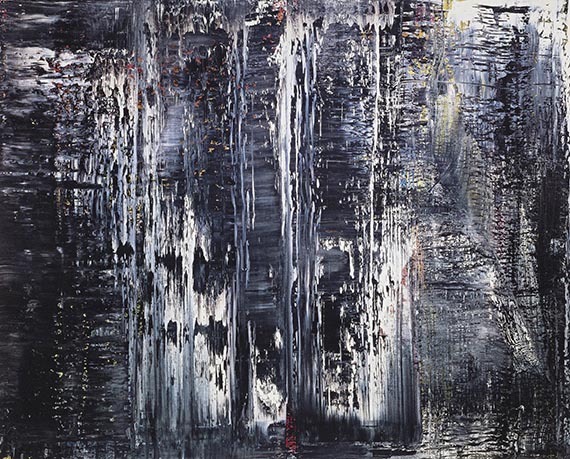
“Abstract Picture” (1989) – a compelling testimony to a new beginning
After a series of somber and gloomy works, some of which bear titles such as “Grat” (Ruth and Ted Baum Collection, Palm Beach), “Uran” (private collection, Cologne), or “December” (The Saint Louis Art Museum, Saint Louis), Richter suddenly attained vibrant and almost liberated colors in a small series of works that includes the present painting. Our composition stands out from the rest in this group for its powerful vernal colors and exceptional formal strength and clarity. The fascinating symbiosis of the flat, horizontal squeegee structure and the accentuating vertical lines foreshadow the “Abstract Paintings” of the early 1990s, in which Richter superimposed strict vertical lines applied with a palette knife over the horizontal color shifts created by the squeegee, as well as the famous cycle “Wald” (Forest, 2005, Museum of Modern Art, New York), in which Richter also used composition principles found in landscape painting to create a stunning composition.
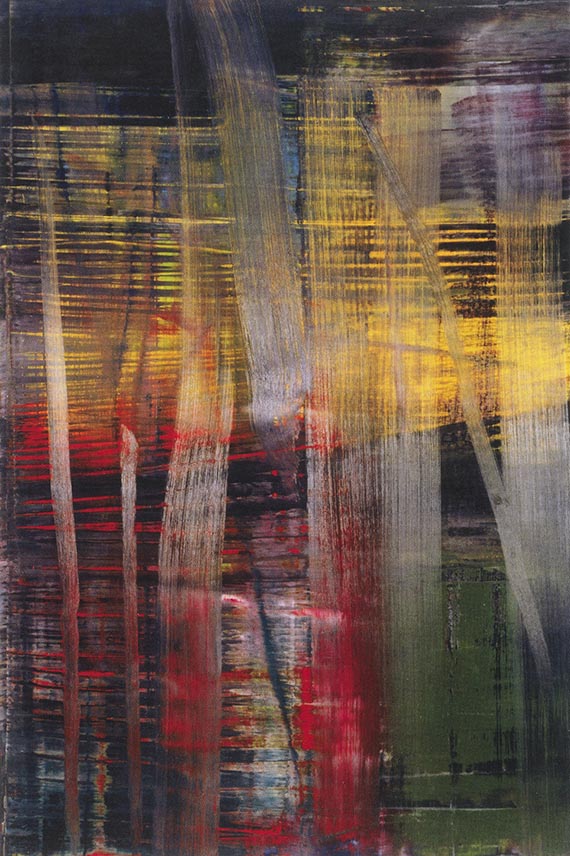
The fresh and vibrant colors, mysteriously enraptured and seemingly bathed in glaring light through the squeegee, give the impression of nature's spring awakening, the visualized mood of an eager revival and vigorous new beginning. While Richter did not give his 'Abstract Pictures,' including this mature composition and descriptive titles, the subtle visual play with the viewer's perception is inherent in all his abstract creations. Richter once described this captivating oscillation: “The pictures live from the viewer's desire to recognize something in them. They show similarities to real phenomena at every point, which cannot be properly realized. It's like in music: moods are created because the notes resemble real sounds, whether plaintive, joyful, shrill, or delicate. [...] They are always reminiscent of something; otherwise, they would not be pictures at all.” (G. Richter, 1999, quoted from: Gerhard Richter, Text 1961 bis 2007, Cologne 2008, pp. 360ff.).
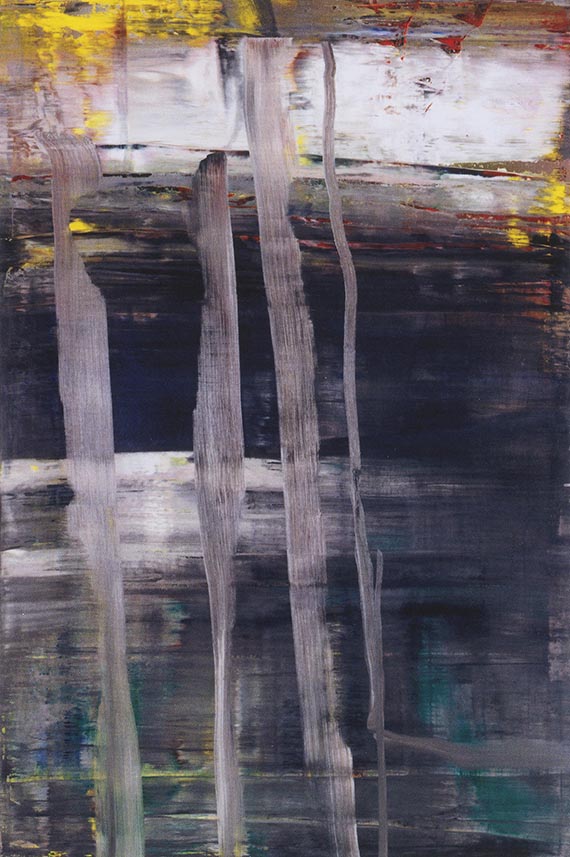
It is not only the observer's perception, as well as Richter's use of color and composition principles, that are modeled on nature, but also the time-consuming creative process behind his “Abstract Pictures,” which can take up to several months, resembling a natural process shaped by time and the cycles of growth and decay, one that cannot be fully grasped by rational thought: “Well, working with chance, arbitrariness, inspiration, and destruction does lead to a certain type of painting, but never to a predetermined painting. The respective painting should emerge from a pictorial or visual logic as if it were inevitable. And because I don't plan the final painting, I hope to achieve the coherence and objectivity that nature [...] always has.” (G. Richter, quoted from: Catalogue raisonné, vol. 4, p. 34). In 2020, the Metropolitan Museum of Art in New York honored the epochal work of the exceptional German artist with the major solo exhibition “Gerhard Richter – Painting After All,” which, like the retrospective “Gerhard Richter. Forty Years of Painting” at the Museum of Modern Art (2002) and the retrospective ‘Gerhard Richter: Panorama’ (2013/14) at Tate Modern, covered the period stretching from Richter's black-and-white photo-paintings to his legendary abstract squeegee paintings. [JS]
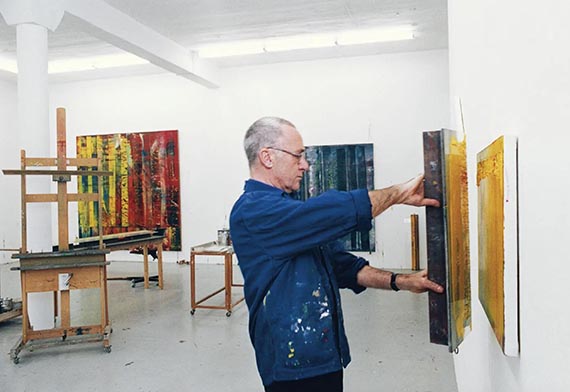
'There comes a point when it is just over,' was Richter's straightforward announcement of the end of his artistic career in 2020. Richter decided that the time had come to officially draw a line under an oeuvre characterized by an almost religious devotion to the squeegee. 'It is not so bad. Moreover, I am old enough now.” (Quoted from: Zeit Online, Sept. 22, 2020) Now that painting with the squeegee, the large spatula-like paint scraper, had become too strenuous, Richter decided to limit himself to small-format works on paper. Anyone who has watched “Gerhard Richter Painting,” the 2011 documentary film by Corinna Belz about the undisputed superstar of the international art scene, will not forget the scenes shot in his studio: They reveal an artist in the throes of creative activity, a process almost silent in its choreography, seemingly following an unpredictable script in the artist's mind. Every step is meticulously planned, and while the result of ever-new and unique color gradients created by the squeegee is mainly unpredictable, it is, in fact, the product of calculated chance.

Gerhard Richter with paintings from the cycle “18. Oktober 1977” (1988, now Museum of Modern Art, New York) in his studio in 1988. Photo: Timm Rautert © Gerhard Richter 2025 (17042025)
In his legendary “Abstract Paintings” series, Richter struck a perfect and fascinating balance between artistic method and chance, ultimately developing his inimitable signature style. What is also intriguing about these works is the perpetual interplay between construction and deconstruction: to create a new aesthetic impression, the existing application of paint must be “destroyed” over and over again. Richter is a rigorous perfectionist: nothing escapes his trained eye, and even the slightest imbalance in the composition or a minor dissonance in the color gradient is either corrected with utmost precision or discarded. The internationally celebrated result of this fascinating working process is a highly diverse and consistently high-caliber painterly oeuvre that, starting with catalogue raisonné number 1, “Tisch” (1962), Richter's first black-and-white photo painting, spans more than half a century and, in terms of its diversity, artistic quality and art-historical appreciation, is comparable only to the oeuvre of Pablo Picasso.

Gerhard Richter, Gegenüberstellung (1), from: 18. Oktober 1977, 1988, oil on canvas, Museum of Modern Art, New York. © Gerhard Richter 2025 (0054)
Richter's apogee – the iconic "October cycle" (1988) and the mature “Abstract Paintings”
The cycle of paintings entitled October 18, 1977 (also known as the RAF or October Cycle), was created in 1988 and purchased for the collection of the Museum of Modern Art, New York, is today it is considered an iconic work that represents a decisive turning point in Richter's practice. The then 56-year-old artist realized that after completing these fifteen black-and-white photo paintings based on press photos showing veiled fragments of the life and death of the terrorists of the Baader-Meinhoff group who were found dead in their prison cells, it would be more than challenging to return to the “Abstract Pictures” that he had started previously. “I also notice that these pictures set a new standard, pose challenges for me. I can go wrong now. [...] But I have already realized that it is difficult for me to continue painting now.” (G. Richter, quoted in: Catalogue raisonné, vol. 4, p. 34). Most of the early ‘Abstract Pictures’ created subsequently display surfaces rendered in a compact, impasto style in leaden greys and somber black-and-white contrasts. A sense of melancholy and squeegee use dominated these impressively dense creations. Henceforth, the paintbrush played only a subordinate role and was mainly used to apply the primer or to partially blend the layers of color. From this point on, the extensive use of the squeegee would be the defining characteristic of his painting. Richter was at the apex of his creative powers when, in the late 1980s, he followed up his early, unique, photo-based black-and-white works, bathed in soft blurring, with his now fully developed “Abstract Pictures.” Because of their outstanding quality and intensity, art historians and Richter have categorized the “Abstract Paintings” of the late 1980s as “mature.” Thanks to their intriguingly novel aesthetic, Richter has enjoyed growing international recognition ever since.

Gerhard Richter, Dezember, 1989, oil on canvas, The Saint Louis Art Museum, Saint Louis. © Gerhard Richter 2025 (0054)
“Abstract Picture” (1989) – a compelling testimony to a new beginning
After a series of somber and gloomy works, some of which bear titles such as “Grat” (Ruth and Ted Baum Collection, Palm Beach), “Uran” (private collection, Cologne), or “December” (The Saint Louis Art Museum, Saint Louis), Richter suddenly attained vibrant and almost liberated colors in a small series of works that includes the present painting. Our composition stands out from the rest in this group for its powerful vernal colors and exceptional formal strength and clarity. The fascinating symbiosis of the flat, horizontal squeegee structure and the accentuating vertical lines foreshadow the “Abstract Paintings” of the early 1990s, in which Richter superimposed strict vertical lines applied with a palette knife over the horizontal color shifts created by the squeegee, as well as the famous cycle “Wald” (Forest, 2005, Museum of Modern Art, New York), in which Richter also used composition principles found in landscape painting to create a stunning composition.

Gerhard Richter, Wald (4), oil on canvas, The Museum of Modern Art, New York. © Gerhard Richter 2025 (0054)
The fresh and vibrant colors, mysteriously enraptured and seemingly bathed in glaring light through the squeegee, give the impression of nature's spring awakening, the visualized mood of an eager revival and vigorous new beginning. While Richter did not give his 'Abstract Pictures,' including this mature composition and descriptive titles, the subtle visual play with the viewer's perception is inherent in all his abstract creations. Richter once described this captivating oscillation: “The pictures live from the viewer's desire to recognize something in them. They show similarities to real phenomena at every point, which cannot be properly realized. It's like in music: moods are created because the notes resemble real sounds, whether plaintive, joyful, shrill, or delicate. [...] They are always reminiscent of something; otherwise, they would not be pictures at all.” (G. Richter, 1999, quoted from: Gerhard Richter, Text 1961 bis 2007, Cologne 2008, pp. 360ff.).

Gerhard Richter, Wald (2), oil on canvas, The Museum of Modern Art, New York. © Gerhard Richter 2025 (0054)
It is not only the observer's perception, as well as Richter's use of color and composition principles, that are modeled on nature, but also the time-consuming creative process behind his “Abstract Pictures,” which can take up to several months, resembling a natural process shaped by time and the cycles of growth and decay, one that cannot be fully grasped by rational thought: “Well, working with chance, arbitrariness, inspiration, and destruction does lead to a certain type of painting, but never to a predetermined painting. The respective painting should emerge from a pictorial or visual logic as if it were inevitable. And because I don't plan the final painting, I hope to achieve the coherence and objectivity that nature [...] always has.” (G. Richter, quoted from: Catalogue raisonné, vol. 4, p. 34). In 2020, the Metropolitan Museum of Art in New York honored the epochal work of the exceptional German artist with the major solo exhibition “Gerhard Richter – Painting After All,” which, like the retrospective “Gerhard Richter. Forty Years of Painting” at the Museum of Modern Art (2002) and the retrospective ‘Gerhard Richter: Panorama’ (2013/14) at Tate Modern, covered the period stretching from Richter's black-and-white photo-paintings to his legendary abstract squeegee paintings. [JS]

Gerhard Richter in his studio painting with the squeegee in 1992, photo: Marc Asnin/Redux/Laif. © Gerhard Richter 2025 (17042025)
12
Gerhard Richter
Abstraktes Bild, 1989.
Oil on canvas
Estimation:
€ 1,500,000 / $ 1,740,000 Résultat:
€ 1,802,500 / $ 2,090,899 ( frais d'adjudication compris)




 Lot 12
Lot 12 